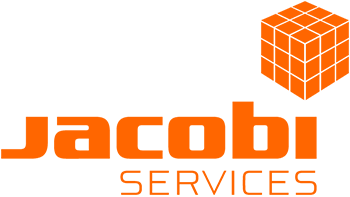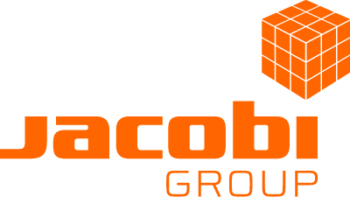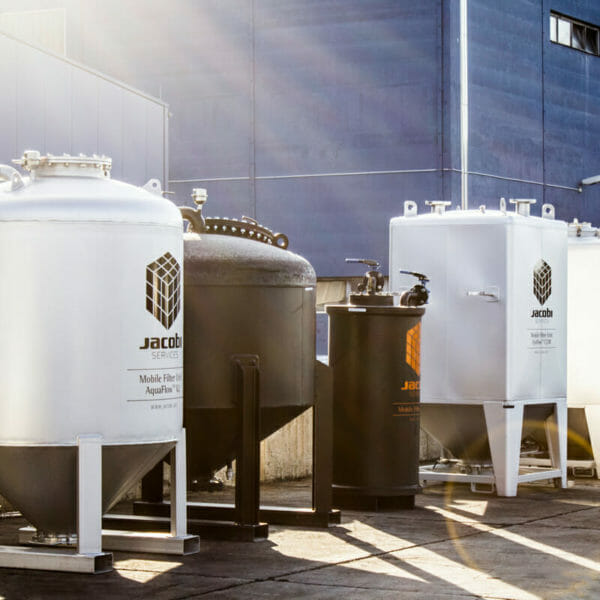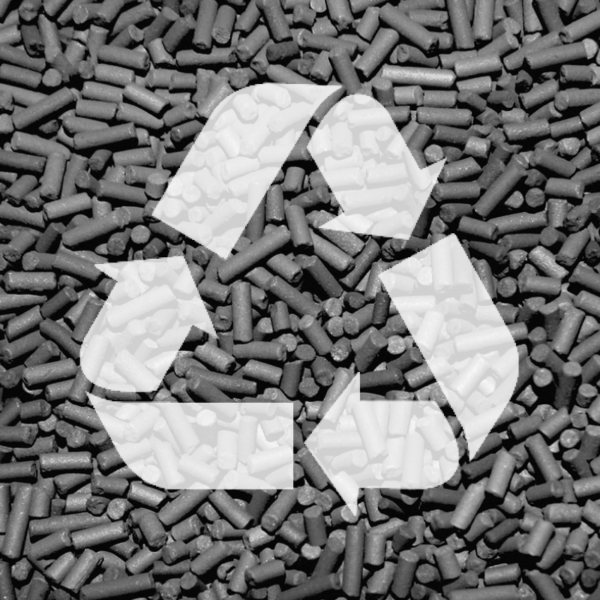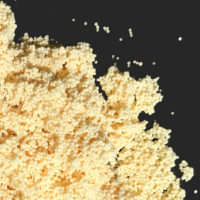Lactose is produced by a separation process of whey, a liquid produced after the precipitation of milk casein in the cheese making process. Non-refined crystal lactose has a yellow taint caused by the presence of vitamin B2. It also contains proteins that are removed during a refining process to make pharmaceutical grade lactose.
Activated carbon is a well-known technology used to remove the yellow colour from lactose solutions.
Refining lactose can be done by adding an acid and powder activated carbon (PAC) to the solution for precipitation of the proteins and removal of the yellow colour caused by the presence of vitamin B2.
Another possibility is a two-step approach where proteins are removed first and mobile adsorbers with granular activated carbon (GAC) then remove the yellow colour.
Converting from powder activated carbon to granular activated carbon has several advantages for the user:
- A reduction of the activated carbon consumption. Granular activated carbon (GAC) consumption is usually less than 30% of powder activated carbon (PAC) consumption.
- Granular activated carbon (GAC) loading is higher compared to the use of powdered activated carbon
- No activated carbon overdosing by operators to avoid off spec products
- Granular activated carbon (GAC) deals better with process fluctuations
- Lower product (lactose) losses:
- The sweetening off process of granular activated carbon (GAC) is more efficient compared to powder activated carbon (PAC)
- Lower carbon consumption means lower volume to be sweetened off
- Sustainability:
- Reactivation has more than five times less CO₂ emissions compared to the production of virgin activated carbon
- Lower GAC consumption leads to lower CO₂ emissions during production compared to powder activated carbon (PAC)
- Lower handling costs
- Lower maintenance costs
LACTOSE PURIFICATION: MOBILE FILTERS
AquaFlow™
The AquaFlow™ V2 mobile adsorbers are designed and built for use in lactose production. The filtration unit is a combined transport vessel and adsorption system delivered, prefilled with selected adsorbent media, to ensure cost effective purification results. The granular activated carbon arrives in a closed container ready for use and so the plant operators do not come into contact with the either fresh or saturated activated carbon.
LACTOSE PURIFICATION: SOLUTIONS
Auxiliary equipment and additional services
In addition to mobile filters and different media, Jacobi Services also offers various items of auxiliary equipment and additional services, including:
A series of removable insulation jackets with electrical heat tracing to maintain the temperature and to protect operators when the mobile filters of the AquaFlow™ range are operated at higher temperature.
Isotherm testing with the user in order to compare the powdered activated carbon with granular activated carbon.
Recycling, Energy Recovery or Disposal Services
Jacobi Services offers customised reactivation ReSorb™ Solo where the spent carbon storage, reactivation and reactivated carbon conditioning are strictly separated from other customers to ensure that a customer gets back his own carbon.
Jacobi Services also offers spent carbon take back and virgin carbon delivery when the annual spent activated volume is too low for customised reactivation.
LACTOSE PURIFICATION: PRODUCTS
ColorSorb™ H620
ColorSorb™ H620 is a high purity, granular activated carbon, that is effective for decolourising a wide range of liquids, including foodstuffs and industrial process streams. The high mesoporosity also allows the effective removal of colour bodies and complex organic molecules and provides an excellent adsorption capacity. An important feature of this material is the supplementary washing process applied during production to reduce the level of soluble inorganics that may cause issues in acidic treatment applications. The product meets the requirements of the Food Chemical Codex. This product can be recycled by thermal reactivation, an environmentally responsible method that helps to reduce atmospheric CO₂ emissions and contributes to the sustainable use of the world’s resources.
ColorSorb™ HP-120
ColorSorb™ HP-120 is a powdered activated carbon, that is effective for decolourising a wide range of mildly discoloured liquids, including foodstuffs and industrial process streams. The product is manufactured from a sustainable raw material and contributes to a net reduction in atmospheric carbon dioxide (CO₂). This grade of activated carbon has a predominantly macroporous structure for efficient diffusion and adsorption of high molecular weight organic substances in liquid phase decolourisation applications. The chemical activation process produces an adsorbent with a surface pH designed to maximise decolourisation performance. The powdered particle size distribution of ColorSorb™ HP-120 is carefully controlled to ensure efficient adsorption kinetics and maintain high filterability characteristics. The product meets the requirements of the Food Chemical Codex.
LACTOSE PURIFICATION: ION EXCHANGE RESINS
Whey Demineralisation
This is achieved by using, first, membrane technology (UF & NF), then electrodialysis (ED), and finally ion exchange resin as a polishing step. Prior to nanofiltration, Resinex™ TPS-2300 and Resinex™ SGC-8 can be used to decalcify whey and increase membranes system recovery. Resinex™ TPS-2300 is intended to remove complexing anions as lactates which lower the softening efficiency of the strong acid cation Resinex™ SGC-8. The demineralisation is accomplished by passing through Resinex™ SGC-10 and Resinex™ TPS-2016 or Resinex™ TPS-2400.
Lactose Recovery from Whey
Lactose can be recovered from whey by chromatographic separation using Finex CS-GC chromatography resins in their sodic form. Lactose, being a neutral specie, is retarded in the resin bed, whereas salts are excluded and come out first. This is called ion exclusion chromatography. Proteins are also excluded from the resin bed because of their size, this is called size exclusion chromatography. During elution, proteins and salts come out first, whereas the lactose fraction exits after. Elution is done with water.
Tagatose Production: Glucose and Galactose Separation
Tagatose, an epimer of fructose is an artificial sweetener which provides less calories and glucose blood level than sucrose. Tagatose is produced by alkaline isomerisation of galactose. Galactose is obtained by enzymatic or acidic hydrolysis of lactose which produces a mixture of D-glucose and D-galactose. Then, the two molecules are separated by ligand-exchange chromatography using Finex CS-GC chromatography resins in their calcium form. After the galactose isomerisation process, the tagatose solution can be demineralised using Resinex™ TPS-1000 and Resinex™ TPS-2019.
GET IN TOUCH
Fill out the short form below and or team will be in touch.
